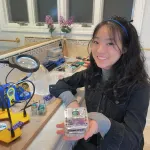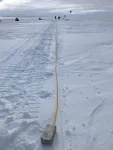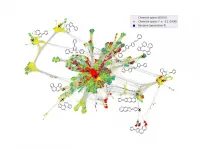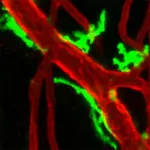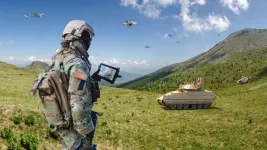INFORMATION:
High school junior's consumer seismometer delivers low-cost earthquake early warning
2021-04-23
(Press-News.org) A Southern California high school junior has built a low-cost seismometer device that delivers earthquake early warnings for homes and businesses. Costing less than $100 for her to make today, the seismometer could someday be a regular household safety device akin to a smart smoke detector, says its inventor Vivien He.
About the size of a Rubik's cube and encased in clear acrylic, the seismometer has a sleek, consumer-ready look. The device's geophone detects incoming ground motion, while onboard hardware and software translate the geophone's electrical signals into a digital waveform. The device has detected all earthquakes over magnitude 3.0 around Los Angeles since September 2020.
When earthquakes are stronger than the alert threshold set by the user, the device can sound the onboard alarm for on-site warning, send a text message to local subscribers of the regional warning service, and can be controlled from a smartphone.
He presented her research on the device at the Seismological Society of America (SSA)'s 2021 Annual Meeting.She also won a SSA Student Travel Grant, the only high school student among all recipients, to attend the conference free of charge. She is a student at Palos Verdes Peninsula High School in Rolling Hills Estates. He thanks her science research class teacher, Melissa Klose, for her guidance on scientific research methods and her support in pursuing research opportunities.
He researched, designed, built, and tested the entire device over a summer and fall spent at home under COVID-19 restrictions. Her home lab occupies a corner of a bedroom with "bedside drawers full of little wires and extra geophones and components." she said.
There was also the bathroom she borrowed where the bright light was good for soldering. For acrylic laser cutting, her dad helped her drag a table out of the garage into the yard as a safety precaution.
"I did--don't tell my mom--but I did one time have a little bit of a fire," she admitted.
The seismometer device fills a gap in current earthquake early warning systems, He said, by providing a consumer-friendly, low-cost but built-for-purpose alternative to more expensive, scientific-grade systems like the West Coast's ShakeAlert system. Her device offers a way for people in earthquake zones to gain a few to tens of seconds of warning to take action and automatically shut down utilities and machinery at work.
He has set up a nonprofit, Melior Earth, to help her get the device to those who need an inexpensive earthquake early warning system. "I do have hopes that I would be able to provide this to lower-income families and neighborhoods with less earthquake-proof infrastructure," she said.
Quiet Under Quarantine
He got the idea for the seismometer after reading a paper about the unusual seismic "quiet" that descended over the earth when COVID-19 lockdowns brought a halt to much human activity. "I was wondering whether I would be able to measure that from my own home," she recalled, "and then that quickly evolved into, I wonder if I can measure in my own home and apply it to earthquake early warning?"
She began reading about earthquake early warning and building a giant three-ring binder of highlighted papers, including many from SSA journals. One of her favorite researchers in the field was Richard M. Allen, director of the Berkeley Seismology Lab.
"I really enjoyed the way he explained earthquake early warning systems and the current systems' limitations," He said.
The research gave He the confidence that she could build a low-cost device for earthquake early warning, taking a consumer-based approach versus the conventional public station-based approach. After that, it was time to figure out the components, the programming and the design. She didn't have much expertise going into the project, however, given much of the skills and knowledge needed were outside of school curriculum.
"I went to an MIT hackathon the other day, and what they said is that the secret for hackers is that they just google everything, right?" she said. "And that's kind of like what I did for this project, like, oh, I don't know how this works, just google it!'"
As He will discuss in her SSA presentation, the device evolved over time as her skills improved and she solved design problems along the way. Along with its alert and notification functions, the final design contains a data card that can hold up to four years' worth of standard earthquake waveform files that can also be used for seismological studies.
"Hey, You Guys Hear That?"
He plugged in her first seismometer one night after midnight last September. "And then I went to sleep, and then the next day I woke up and there had been an earthquake in Los Angeles and I was like, oh, it's fate!"
She compared the seismic signal captured by her device to one produced by a U.S. Geological Survey station near her house, "and the waveform looked the same," she recalled.
One of the early successes of her testing period came when "my family was all in the living room and we were all talking and the device started beeping and I said, 'Hey, you guys hear that?' And they were like, 'is it an earthquake?' and then the pendant lights started shaking," she said.
The seismometer has since successfully detected several recent earthquakes in Southern California, and He has competed in science fairs at her school district and Los Angeles County. There, she won the International Science and Engineering Fair (ISEF) Finalist award, which moves her on to compete at the international level next. In addition, she won the Association of Women Geoscientists Award, the Cheryl Saban Self-Worth Foundation for Women & Girls 1st Place Award and Scholarship, and the Professional Engineers in California Government's Marylin Jorgenson-Reece Award of Excellence and Scholarship.
He, who turned 17 in February, is working on getting a utility patent for the device. She plans to use her nonprofit to drive consumer adoption for the device, especially making earthquake early warning accessible for the lower-income countries, regions and population.
"The whole point of it is that it would be a consumer product, but I'm not focused on the monetary gain of it," she explained. "I'm more focused on the science of it and just the impact in general on people and on earthquake disaster prevention."
ELSE PRESS RELEASES FROM THIS DATE:
Fiber optic cable monitors microseismicity in Antarctica
2021-04-23
At the Seismological Society of America's 2021 Annual Meeting, researchers shared how they are using fiber optic cable to detect the small earthquakes that occur in ice in Antarctica.
The results could be used to better understand the movement and deformation of the ice under changing climate conditions, as well as improve future monitoring of carbon capture and storage projects, said Anna Stork, a geophysicist at Silixa Ltd.
Stork discussed how she and her colleagues are refining their methods of distributed acoustic sensing, or DAS, for microseismicity--earthquakes too small to be felt. DAS works by using the tiny internal flaws within an optical fiber as thousands of seismic ...
DeepShake uses machine learning to rapidly estimate earthquake shaking intensity
2021-04-23
A deep spatiotemporal neural network trained on more than 36,000 earthquakes offers a new way of quickly predicting ground shaking intensity once an earthquake is underway, researchers report at the Seismological Society of America (SSA)'s 2021 Annual Meeting.
DeepShake analyzes seismic signals in real time and issues advanced warning of strong shaking based on the characteristics of the earliest detected waves from an earthquake.
DeepShake was developed by Daniel J. Wu, Avoy Datta, Weiqiang Zhu and William Ellsworth at Stanford University.
The earthquake data used to train ...
Seismicity on Mars full of surprises, in first continuous year of data
2021-04-23
The SEIS seismometer package from the Mars InSight lander has collected its first continuous Martian year of data, revealing some surprises among the more than 500 marsquakes detected so far.
At the Seismological Society of America (SSA)'s 2021 Annual Meeting, Savas Ceylan of ETH Zürich discussed some of the findings from The Marsquake Service, the part of the InSight ground team that detects marsquakes and curates the planet's seismicity catalog.
Marsquakes differ from earthquakes in a number of ways, Ceylan explained. To begin with, they ...
Toward new solar cells with active learning
2021-04-23
How can I prepare myself for something I do not yet know? Scientists from the Fritz Haber Institute in Berlin and from the Technical University of Munich have addressed this almost philosophical question in the context of machine learning. Learning is no more than drawing on prior experience. In order to deal with a new situation, one needs to have dealt with roughly similar situations before. In machine learning, this correspondingly means that a learning algorithm needs to have been exposed to roughly similar data. But what can we do if there is a nearly infinite amount of possibilities so that it is simply impossible to generate data ...
Newly discovered immune cell function vital to healing
2021-04-23
Cardiovascular disease, the most common cause of death, is the result of oxygen deprivation as blood perfusion to affected tissue is prevented. To halt the development of the disease and to promote healing, re-establishment of blood flow is crucial. Researchers at Uppsala University have now discovered that one of the most common immune cells in the human body, macrophages, play an important role in re-establishing and controlling blood flow, something that can be used to develop new drugs.
The classic function of immune cells is to defend the body against attacks from microorganisms and tumour cells. Macrophages are immune cells specialised in killing and consuming microorganisms but they have ...
Travel paths of primates show how their minds work
2021-04-23
How primates get from A to B gives vital information about their cognitive evolution, say researchers in a new study looking at the travel paths of animals in the wild. Using data from 164 wild primate populations, the global survey examines the mental abilities that primates, including ourselves, use to know where and when to travel in the most efficient way.
A birds eye view
Co-author Miguel de Guinea, expert in Evolutionary Anthropology at Oxford Brookes University commented: "Imagine looking down on a huge outdoor market from high in the sky, perhaps from a drone hovering quietly above. The people below move in different ways. Some wander haphazardly among the stalls: they are learning what's available but are clearly not busy. Others take bee-line routes ...
Hubble captures giant star on the edge of destruction
2021-04-23
In celebration of the 31st anniversary of the launching of NASA's Hubble Space Telescope, astronomers aimed the renowned observatory at a brilliant "celebrity star," one of the brightest stars seen in our galaxy, surrounded by a glowing halo of gas and dust.
The price for the monster star's opulence is "living on the edge." The star, called AG Carinae, is waging a tug-of-war between gravity and radiation to avoid self-destruction.
The expanding shell of gas and dust that surrounds the star is about five light-years wide, which equals the distance from here to the nearest star beyond the Sun, Proxima Centauri.
The huge ...
New data could inform youth-focused pandemic messaging
2021-04-23
Now that teens and young adults across the country account for an increasing share of COVID-19 cases, and many have become eligible for vaccination, several recently published studies based on polls of this age group provide insights into the kinds of messaging that might work best for both preventing transmission and vaccine uptake.
Using data from text-message polls of people between the ages of 14 and 24 taken at several points in 2020, researchers from the University of Michigan find a clear theme: that most young people are taking COVID-19 seriously and trying to follow public health guidance, and that many of them they are motivated by the desire to protect ...
Army, ASU publish human-autonomy communication tips
2021-04-23
ABERDEEN PROVING GROUND, Md. -- Army and Arizona State University researchers identified a set of approaches to help scientists assess how well autonomous systems and humans communicate.
These approaches build on transformational scientific research efforts led by the Army's Robotics Collaborative Technology Alliance, which evolved the state of robots from tools to teammates and laid the foundation for much of the service's existing research into how humans and robots can work together effectively.
As ideas for autonomous systems evolve, and the possibilities ...
Critical understanding of why and how solid-state batteries
2021-04-23
Researchers from the Faraday Institution's SOLBAT project have made a significant step in understanding how and why solid-state batteries (SSBs) fail. A paper, published in Nature Materials on 22 April, provides answers to one important piece of the scientific puzzle.
To make step changes in electric vehicle (EV) battery range and safety at a lower cost, new battery chemistries that are "beyond lithium ion" must be developed. SSBs are one such promising technology, but mass market adoption has been held back by several key technical challenges that cause the battery to fail when charged and discharged.
SSBs can short circuit after repeating charging and discharging. One well-recognised cause of battery failure is the growth of dendrites, branching networks of lithium that ...
